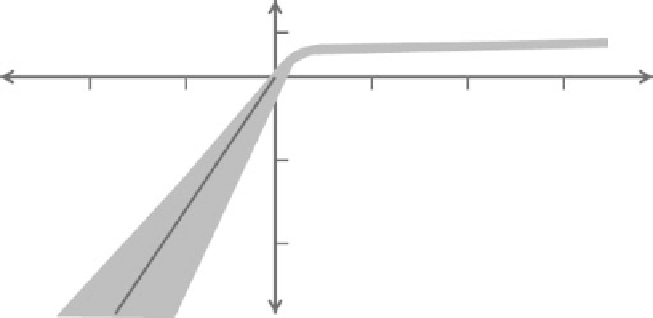Geoscience Reference
In-Depth Information
Figure 20.1
Approximate
relationship between the flux
Richardson number and
(z-d)/L based on
observations.
Unstable
Stable
25
−
2
−
1
1
2
3
(
z
−
d
)
L
−
0.5
−
1.0
R
f
g w
(
q¢ ¢
)
v
(
zd
−
)
−−
kz dg w
(
)
(
q¢ ¢)
q
=
v
=
v
(20.11)
L
3
u
q
()
u
⎛
⎞
2
(
−
u
)
*
v
*
⎜
⎟
*
⎝
kz d
(
−
)
⎠
Substituting for
t
k
from Equation (19.19) and then for
u
*
from Equation (19.20),
the denominator of the right hand side of Equation (20.11) gives the flux
Richardson number as defined by Equation (19.2). However, observations in the
ABL suggest the more general relationship shown in Fig. 20.1, with the flux
Richardson number,
R
f
, approximately equal to (
z
-
d
)/
L
within experimental error
in unstable and neutral conditions. In stable conditions they are related by:
⎡
(
zd
−
)
⎤
0.74
+
4.7
⎢
⎥
(
zd
−
)
L
⎣
⎦
R
≈
(20.12)
f
L
2
(
zd
L
−
)
⎡
⎤
14.7
+
⎢
⎥
⎣
⎦
Flux-gradient relationships
As previously stated, to generalize the application of mixing length in the surface
layer it is necessary to parameterize the dimensionless expressions
f
M
,
f
H
and
f
V
as
functions of (
z
-
d
)/
L
, the selected dimensionless measure of buoyant production/
destruction. During the 1960s and 1970s, several field experiments were carried
out which sought to define the required form for these (assumed universal)
dimensionless expressions. These suggested that in neutral and stable conditions
the three functions are the same within experimental error (i.e.,
f
M
f
V
), but
that in unstable conditions, although
f
H
and
f
V
are the same,
f
M
differs and in fact
f
M
2
=
f
H
=
=
f
H
=
f
V
. Eventually, a reasonable consensus emerged on the functional forms








